Share On Social!
Shape Up San Francisco, a coalition of community leaders, wanted to know if kids in San Francisco were meeting state requirements for time spent in PE. They convened a group called the PE Advocates and began to study 20 elementary, four middle, and four high schools. After learning that almost 80% of elementary schools were not getting enough PE time, Shape Up SF’s PE Advocates partnered with school officials to develop a plan to change this. Now, thanks to the partnership, the district has 38 PE specialists to train teachers in the skills needed to provide students with quality PE.
EMERGENCE
Awareness: Local health advocates Christina Goette and Marianne Szeto were concerned about the city’s growing childhood obesity rates and health disparities.
The number of overweight children in fifth, seventh, and ninth grades soared from 24.4% in 2004 to 32.2% in 2010, according to a 2012 report.
Learn: Fortunately, Goette and Szeto were not the only ones concerned with the rise in childhood obesity. Policy makers, nonprofit groups, health professionals, and educators were concerned, too.
In 2006, individuals from a variety of different backgrounds convened to discuss solutions to the rising obesity rates.
Shape Up San Francisco (Shape Up SF), a public-private health partnership led by the city’s health department, was born.
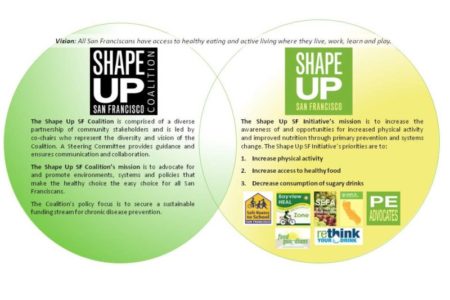
They created a five-year strategic plan (2009-2014) to prevent chronic disease by improving health in neighborhoods, schools, worksites, and health care systems.
The Shape Up San Francisco Physical Activity Council (PAC), an outgrowth of the strategic plan, looked for resources to start learning more about the state of physical activity in San Francisco.
One of these resources was the Physical Education Research for Kids (PERK) report, produced by the California Task Force on Youth and Workplace Wellness. The 2010 report looked specifically at the state of PE in California’s K-12 schools and found that, according to most teachers, kids were not meeting state requirements for time spent in PE.
California state law (edc: 51210-51212) requires elementary school children to receive at least 200 minutes of PE every 10 days. That’s 100 minutes of PE every week.
Another study found that Latino kids in California were more likely to attend schools that were non-compliant with this state law.
Dr. Emma Sanchez, a Salud America! grantee, examined data from 60,817 5th grade Latino students and found that 57% were overweight or obese and 41% were physically unfit. Of these students, only 15.7% attended school districts that complied with the state’s PE law.
Frame Issue: After learning that kids across the state were lacking PE time, the PAC decided that it would be wise to further investigate the situation in San Francisco. They conducted their own policy analysis of the best practices that could get San Francisco residents up and moving. Interestingly, in most San Francisco elementary schools PE is taught by classroom teachers, rather than a certified PE teacher.
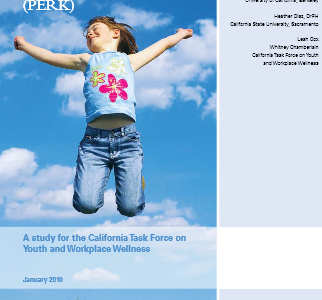
“We recognized a huge need,” Szeto said. “There was a big gap around physical activity, and PE really is the equitable way for all kids to have access to physical activity.”
One common theme that stood out in both the PERK report and the Shape Up SF policy analysis was the need to improve PE standards in schools.
Szeto said the group knew that if they really wanted to improve PE in schools, they would need to collaborate with the San Francisco Unified School District (SFUSD), the only district in San Francisco city and county.
They soon met with Michelle Zapata, the Physical Education Program Administrator of SFUSD, and learned that thanks to a 2004 voter-approved fund, some elementary schools now had access to PE specialists.
At the time, the district had hired 15 PE specialists as part of a master plan to improve PE in elementary schools.
Although general education teachers now had support from the PE department, not everyone was taking advantage of this, and limited funding kept the district from being able to provide a specialist at every school. According to Zapata, some schools didn’t think they needed a PE specialist and the PE department was facing barriers in implementing the PE master plan.
DEVELOPMENT
Education: Beginning in May 2010, Shape Up SF formed the PE Advocates—a group of concerned individuals from the SFUSD PE Department, PTA members, small businesses, SFUSD administrators, principals, teachers and graduate students. The diverse group was unified in its belief that PE is the equitable way for students to get regular physical activity, Szeto said. They discussed barriers teachers face in implementing PE, and the PERK report findings.
Shape Up SF also expressed interest in assessing PE in SFUSD schools and hosting a forum to inform the community of the study’s findings.
“We had to first understand what the state of PE was,” Szeto said. “So we decided to do a PE assessment in 28 elementary schools.”
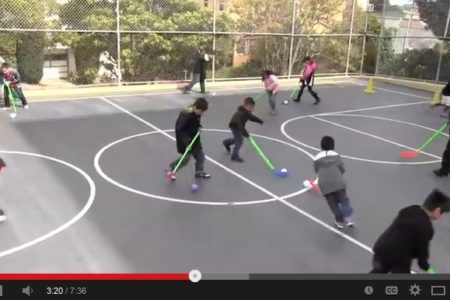
Mobilization: Not long afterward, the group filed a research application to conduct the assessment with the SFUSD Research, Planning & Accountability Department.
A key member of the PE Advocates, Dr. Kristine Madsen, a physician-researcher with the University of California, San Francisco (UCSF), led the study in randomly selected elementary schools (20), middle schools (4), and high schools (4) from March-May 2011.
Using tools like the System for Observing Fitness Instruction Time (SOFIT) to measure levels of activity, as well as surveys and interviews, Madsen’s team collected data from SFUSD students, teachers, principals, and parents.
The PE Advocates then presented study results to SFUSD district leaders.
“The district’s research department was very concerned about the findings,” Szeto said. “It was sort of a wake-up call that really helped us get on the radar.”
Brent Stephens, Assistant Superintendent for the Elementary Division of the SFUSD, had recently joined the district and happened to be at that meeting. When he learned that 80% of elementary schools were not achieving the mandated 200 minutes of PE, he agreed that improvements in PE had to be made.
“It was at that meeting that we all met each other, and that we decided we had to partner up,” Stephens said.
Debate: According to Zapata and Stephens, many schools scheduled PE but there were a number of problems with implementation.
“Every school has unique needs and faces different challenges,” Zapata said.
Stephens said, things like field trips, library time, and teachers running over time with lessons were part of the problem.
“It was hard to change how teachers think about it [PE] because they already had a lot on their plate,” Zapata said.
The district worked with Shape Up SF’s PE Advocates to have them present their findings to school principals.
We got to know one another better and think together about the kind of meaningful goals we could establish for principals,” Stephens said.
ENACTMENT
Activation: Shape Up SF ended up making three recommendations for SFUSD:
- Increase awareness of the benefits of PE and physical activity;
- Meet state mandates for the amount of PE provided; and
- Develop and implement measures to ensure equal access of PE at all SFUSD schools.
To start meeting the recommendations, the district organized professional development activities between the PE department and school principals. They also collected master schedules from across the district to make sure that schools were allotting enough time for PE. The PE department crafted videos that demonstrated a good PE lesson to teachers and later a plan was devised to provide every classroom with PE support.
“All of those things represented new work for us,” Stephens said. “The Shape Up SF study was looking at clearly measured outcomes for PE, and these were things that principals could understand…The partnership [with Shape Up SF] made it much more possible for them [PE specialists] to start working with school leaders.”
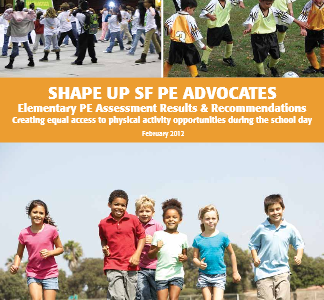
Shape Up SF’s PE Advocates also did their part by raising awareness of the benefits of PE. They created informational materials for PTA parents and organized a speaker series of guests like Ken Dyer, John Ratey, and Darin Curtis, who all had experience improving PE in schools, in order to provide the PE advocates with knowledge of ways to improve the state of PE in elementary schools. Another key strategy they employed was to have a PE Advocate regularly attend a local Board of Education meeting to provide public comment about why PE matters, to keep it part of the discussion and on the Board’s radar.
Frame Policy: UCSF researchers proposed four goals to improve the quality and quantity of PE in elementary schools. These included:
- Meeting state requirements for PE (200 minutes per 10 days) while sticking to regularly scheduled PE times;
- Increasing moderate-to-vigorous physical activity (MVPA);
- Increasing skill development by following California’s Model Content Standards for Physical Education; and
- Providing a more user-friendly and relevant curriculum.
Because the district could not afford to hire a certified PE teacher at every school, the district decided to roll out a new plan to eventually bring a PE specialist to every elementary school (about 70 schools) in the SFUSD. Specialists would provide training and support to teachers for up to two years and then move on to another school in need of PE assistance.
Change: In January 2012, the district hired six new PE specialists to increase the quality and quantity of PE across district schools.
During the first year of the changes, the district used funding from the voter-approved Public Education Enrichment Fund (PEEF) to allow principals and teachers to apply to station a PE specialist at their school. Schools that were selected were required to meet certain expectations which included making sure that every teacher received sufficient time to work with the PE specialist on a regular basis.
Today, every school in the district has received PE support from one of the specialists.
“PE specialists aren’t just providing PE classes,” Stephens said, “they’re training general education teachers to learn to become better teacher-coaches who are far more skilled in delivering quality PE instruction.”
IMPLEMENTATION:
Implementation: Mario Chang, a teacher at Mission Ed Center, a K-5th grade school with a transitional program for Spanish-speaking immigrant children, was one of the first teachers to request support from the district.
“I went to another teacher and said. ‘Let’s tell the principal we want to do this,’ and the principal said, ‘OK, let’s do this,’” Chang said.
During the first year of changes, principals and teachers who requested the support of PE specialists were the ones who got it.
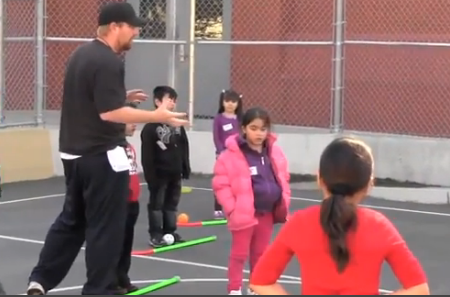
PE specialists were placed in 30-35 elementary schools (almost half of all elementary schools in the district).
A few months later while discussing the program’s goals, the district developed a cohort model to get a specialist into each school. Principals would choose which cohort they wanted to belong to and organize the school’s master schedule to make sure that every teacher got support once the PE specialist arrived.
“It’s been helpful having a partner that’s not interested in pointing fingers but rather providing information to help us get better at what we are doing,” Stephens said. “Part of what I think has been great about the partnership, is that it’s been very honest about the challenges. PE competes during the school day with regular instruction in reading, math and other subjects.”
According to Stephens, having a very diverse group of educators, researchers, public health advocates, and supervisors give their input, was something that really set the tone for collaboration.
Chang agrees.
“Before teachers didn’t want to teach PE because they didn’t know how,” he said. “But the specialist really showed us how to do it and it’s a fun thing.”
Zapata said that principals now see that it is possible to offer PE as a part of the regular school day without sacrificing time spent learning other core subjects.
For instance, teachers at El Dorado Elementary School, one of the districts “zone schools” (historically low-achieving schools), have successfully implemented PE over the last two years.
Equity/Sustainability: Thanks to the efforts of Shape Up SF PE Advocates and the work of this partnership, many elementary school students can now enjoy an improved quality of PE.
Still, Chang said continual buy-in is needed from teachers and the community.
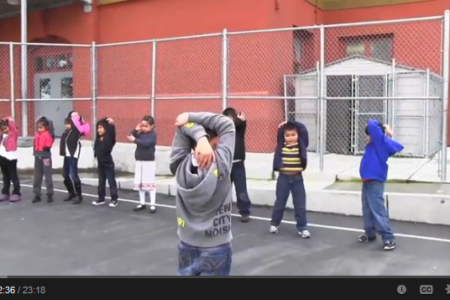
In order to continue motivating teachers, in 2012 Shape Up SF decided to hold a competition to find PE champions for the district. Chang, Stella Lau of the Chinese Immersion School at DeAvila Elementary School, and teachers Lindsay Hatfield and Jennifer Moless of the El Dorado Elementary School were nominated as the district’s PE champions.
With funding from Kaiser Permanente and the California Obesity Prevention Program, videos of these champions were produced and shown to elementary school teachers across the district and all across the community, in efforts to increase support for PE.
Shape Up SF played the videos at various meetings including a screening of the Weight of the Nation (115 viewers), a SFUSD elementary school principals meeting (50 viewers), a SFUSD Food and Fitness committee meeting (12 viewers), and a health advocates meeting (44 viewers). They also distributed video links through e-newsletters, social media accounts (Twitter, Facebook, Youtube), listservs, school district mailing lists, and the Shape Up SF PE webpage. They estimate that videos of the PE advocates have potentially reached more than 20,000 individuals to date.
The district’s PE advocates continue to meet every quarter to talk about progress in PE. The district recently funded an assessment of the same 20 elementary schools that were originally studied by Shape Up SF, to determine the impact of the new changes.
According to Stephens they’re finding that the new changes are headed in the right direction.
Additional Links:
www.shapeupsfcoalition.org
Elementary schools shirking PE time, SF Examiner
Shape Up San Francisco: 2009 Strategic Plan
PE Advocate Tools and Resources
Portraits of PE Champions Video
Journal Article: Are Physical Education Policies Working? A Snapshot From San Francisco, 2011
This success story was produced by Salud America! with support from the Robert Wood Johnson Foundation. The stories are intended for educational and informative purposes. References to specific policymakers, individuals, schools, policies, or companies have been included solely to advance these purposes and do not constitute an endorsement, sponsorship, or recommendation. Stories are based on and told by real community members and are the opinions and views of the individuals whose stories are told. Organization and activities described were not supported by Salud America! or the Robert Wood Johnson Foundation and do not necessarily represent the views of Salud America! or the Robert Wood Johnson Foundation.
By The Numbers
84
percent
of Latino parents support public funding for afterschool programs
This success story was produced by Salud America! with support from the Robert Wood Johnson Foundation.
The stories are intended for educational and informative purposes. References to specific policymakers, individuals, schools, policies, or companies have been included solely to advance these purposes and do not constitute an endorsement, sponsorship, or recommendation. Stories are based on and told by real community members and are the opinions and views of the individuals whose stories are told. Organization and activities described were not supported by Salud America! or the Robert Wood Johnson Foundation and do not necessarily represent the views of Salud America! or the Robert Wood Johnson Foundation.



